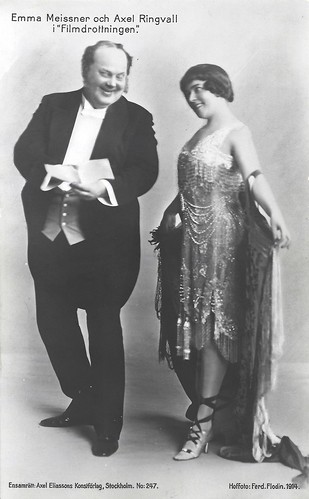
Swedish postcard by Axel Eliassons Konstförlag, Stockholm, no. 247. Photo: Hofatelier Ferd. Flodin, 1914. Emma Meissner and Axel Ringvall in the operetta 'Die Kino-Königin' (1913) by Jean Gilbert, performed as 'Filmdrottningen in Sweden.

Swedish postcard by Axel Eliassons Konstförlag, Stockholm, no. 308. Photo: Hofatelier Jaeger, Stockholm, 1914. Lars Hanson.

Swedish postcard by Axel Eliassons Konstförlag, Stockholm, no. 353. Photo: Hofatelier Jaeger, Stockholm, 1915. Anders de Wahl in the stage play 'Äventyret aka Äfventyret' by Valentin Le Barroyer, performed at the Dramaten theatre in Stockholm in 1915, under the direction of Karl Hedberg.

Swedish postcard by Axel Eliassons Konstförlag, Stockholm, no. 413, mailed in 1916. Photo: Uno Falkengren, Göteborg. Gösta Ekman.

Swedish postcard by Axel Eliassons Konstförlag, Stockholm, no. 482. 'Gustav III' was a play by August Strindberg and this card refers to one of Lars Hanson's stage play performances, not a film. Hanson played the title role in 1915 (dir. Einar Fröberg) and again in 1928 (dir. Rune Carlsten).

Swedish postcard by Axel Eliassons Konstförlag, Stockholm, no. 35. Photo: Hofatelier Jaeger, Stockholm, 1917. Tora Teje.
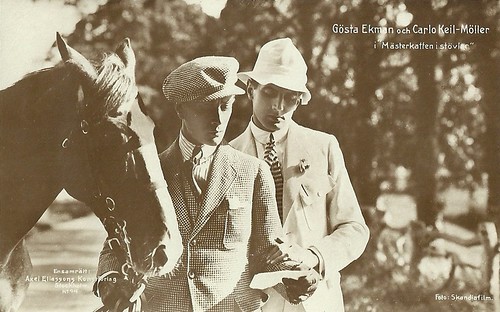
Swedish postcard by Axel Eliassons Konstförlag, Stockholm, no. 94. Photo: Skandiafilm. Gösta Ekman and Carlo Keil-Möller in the Swedish silent romantic film Mästerkatten i stövlar/Puss in boots (John W. Brunius, 1918).
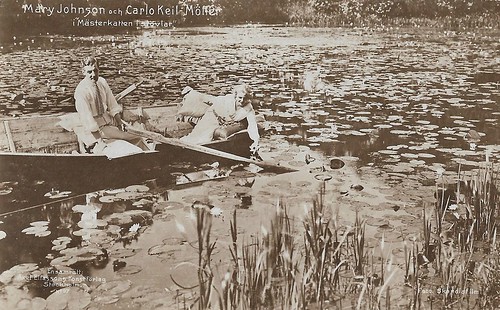
Swedish postcard by Axel Eliassons Konstförlag, Stockholm, no. 97. Photo: Skandia Film. Mary Johnson and Carlo Keil-Möller in the Swedish silent romantic film Mästerkatten i stövlar/Puss in boots (John W. Brunius, 1918).

Swedish postcard by Axel Eliassons Konstförlag, Stockholm, no. 105. Photo: Skandiafilm, 1918. Karin Molander in Surrogatet (Einar Bruun, 1919).
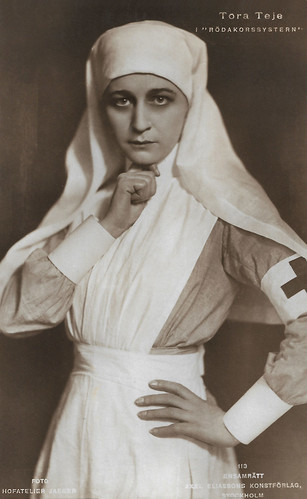
Swedish postcard by Axel Eliassons Konstförlag, Stockholm, no. 113. Photo: Hofatelier Jaeger. Tora Teje in the play 'Rödakorssystern' (Red Cross Sister) by Gustaf Collijn. The play premiered on 14 March 1919 at the Svenska Teatern. The director was Gunnar Klintberg and her co-star was Gösta Ekman.
'Swedish-made' postcards
Axel Eliassons Konstförlag (AE) was founded in Stockholm in 1890. In the first half of the 20th century. AE with its premises on the famous street Drottninggatan, was Sweden's leading producer of postcards. Founder Axel Eliasson was born on 16 February 1868 in Stockholm. He was the son of the clothing merchant Meyer Eliasson and Ida Davidsson. In 1890 he founded the company Axel Eliasson (AE) in Stockholm. He got the idea for his postcard production in Berlin, where he studied at the Rakow Economic School. Initially, Eliasson himself was behind the camera, so he was able to market his products as 'Swedish-made'.
Eliasson's first postcards were sold in the middle of 1891. These showed Stockholm and Gothenburg and were advertised in the newspaper Aftonbladet. However, these first postcards, where the image only took up 1/3 of the front page, were not very successful. Only after Eliasson changed the layout and enlarged the size of the pictures in 1896, their popularity increased. Apart from topographical postcards, Eliasson decided to produce greetings postcards for his own company but also for other companies in Scandinavia. In an interesting article in the magazine Postcard Album, Arne Sandström writes that Eliasson never printed his postcards himself. He ordered most of them from different printers in Germany (including Rotophot) and some also from printers in Sweden, the U.K. and the U.S.A. In 1933, the company probably started to print its own cards.
In 1894 painter and illustrator Jenny Nyström was contracted to draw greeting postcards. Axel Eliasson Konstförlag had exclusive rights to postcards with her motifs of the 'jultomte' (goblins) on numerous Christmas cards, thus linking the Swedish version of Santa Claus to the gnomes of Scandinavian folklore. Her illustrated Christmas cards became one of Eliassons's main products. From 1895 the AE postcards were also published in colour lithography and in 1897 Anna Palm joined the company. She illustrated the 'official' postcards of the 1897 Stockholm Exhibition which were widely distributed. Till 1898, the AE cards were not numbered.
Axel Eliassons Konstförlag had the reproduction rights to the photographs of royalty and famous people by Atelier Jaeger, a photo studio founded in 1858 by Johannes Jaeger. Valentin Wolfenstein bought the studio in 1890, and Albin Roosval and Herman Sylwander acquired the company in 1905 and kept the name. The AE logo was introduced around 1920 and was designed by David Blomberg, who had previously designed the NK logo. In 1922, the name Konstförlag was added to the company name. Eventually, postcard motifs from all over Sweden, Denmark and Norway were published, some of which were hand-coloured. At the end of the 1930s, small booklets with ten motifs from the same city on loose photographs were available in 10x6 cm format.
Axel Eliasson died on 23 January 1932 in Stockholm. He was married to Ester Sterner (1880-1951), who after his death remarried in 1938 to Axel Widstrand, a naval doctor. After Axel Eliasson's death, his son Georg Eliasson became the managing director. The publishing house was transformed into a limited company. Axel Eliassons Konstförlag expanded until the 1920s, but its success stalled in the 1930s. In 1940 the company went bankrupt and closed. However, the liquidation was not finalised until 1941. By then the company had already been bought by Alrik Hedlund Förlag in Gothenburg, which created Nya Aktiebolaget Axel Eliassons Konstförlag. In 1943 the name was changed to Axel Eliassons Konstförlag Aktiebolag and in 1969 to Axel Eliasson Aktiebolag. When Sven-Göran Östh, previously CEO of Gerhard's Konstförlag, became CEO of the company in 1989, he decided to move the company to Sågmyra. The company still exists under the name of Axel Eliasson AB in Sågmyra. It is no longer active in the postcard business and mainly produces art publishing items such as Christmas cards and gifts.
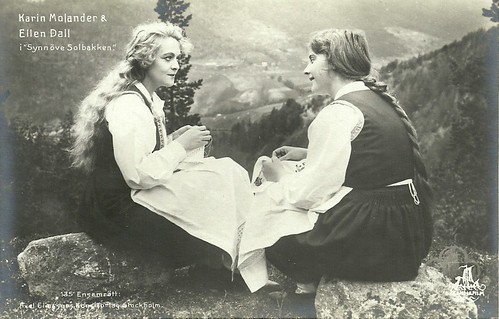
Swedish postcard by Axel Eliassons Konstförlag, Stockholm, no. 135. Photo: Skandia Film. Karin Molander and Ellen Dall in Synnöve Solbakken (John W. Brunius, 1919), adapted from Bjørnstjerne Bjørnson's Norwegian homonymous novel (1857).

Swedish postcard by Axel Eliassons Konstförlag, Stockholm, no. 154. Photo: Skandia Film. Ernst Rolf, Mary Gräber, and Erik Lindholm in the Swedish silent comedy Åh i morron kväll/Oh Tomorrow Night!, (John W. Brunius, 1919).

Swedish postcard by Axel Eliassons Konstförlag, Stockholm, no. 255. Photo: Gösta Hard. Richard Lund.

Swedish postcard by Axel Eliassons Konstförlag, Stockholm, no. 288. Photo: Skandia-Film. Pauline Brunius, Tore Svennberg, Renée Björling and Paul Seelig in the Swedish silent drama En vildfågel/Give Me My Son (John W. Brunius, 1921). Adapted from the play 'Skeppsbrott' (Shipwreck) by Samuel A. Duse. The title translates literally as 'The Wild Bird'. On 3 October 1921, En vildfågel premiered simultaneously in five cinemas in five Swedish cities.

Swedish postcard by Axel Eliassons Konstförlag, Stockholm, no. 303. Photo: Skandia Film, Stockholm. Jenny Hasselqvist and Ivan Hedqvist in the Swedish silent film Vem dömer/Love's Crucible (Victor Sjöström, Skandia Film 1922). The film is a Renaissance drama where a young woman named Ursula (Jenny Hasselquist), who is in love with Bertram, the son (Gösta Ekman) of the mayor (Tore Svenberg), is accused of having poisoned her older husband, the sculptor Master Anton (Ivan Hedqvist). She has to prove her virginity through a fire test. The film's title reads: Who judges?

Swedish postcard by Axel Eliassons Konstforlag, Stockholm, no. 305. Photo: Skandia Film, Stockholm. Jenny Hasselqvist, Ivan Hedqvist, Tore Svennberg and Gösta Ekman in the Swedish silent film Vem döme/ Love's Crucible, (Victor Sjöström, 1922). The film is a Renaissance drama where a young woman named Ursula (Hasselqvist), who is in love with Bertram, the son (Ekman) of the mayor (Svenberg), is accused of having poisoned her older husband, the sculptor Master Anton (Hedqvist). She has to prove her virginity through a fire test. The film's title reads: Who judges? NB Nils Asther had a small part in this film. He is the man just left of Hasselquist.

Swedish postcard by Axel Eliassons Konstförlag, Stockholm, no. 310. Photo: Gösta Hard, Stockholm, 1927. On this postcard, Mary Johnson is indicated with the name of her second husband.

Swedish postcard by Ed. Axel Eliassons Konstförlag, Stockholm, no. 336. Photo: Svensk Filminspelning. Victor Sjöström and Jenny Hasselquist in Eld ombord/Fire on board (Victor Sjöström, 1923).

Swedish postcard by Axel Eliassons Konstförlag, Stockholm, no. 379, 1924. Photo: Svenska-Film. Mona Mårtenson as Ebba Dohna in Gösta Berlings saga/The Atonement of Gosta Berling (Mauritz Stiller, 1924), based on the novel by Selma Lagerlöf.
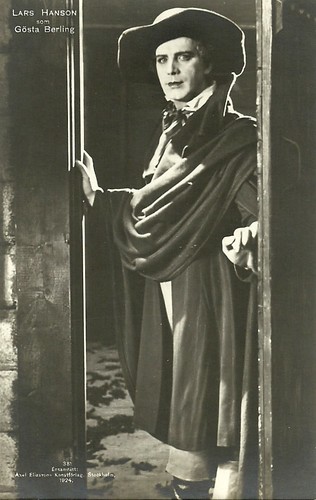
Swedish postcard by Axel Eliassons Konstförlag, Stockholm, no. 381. Lars Hanson is the title character in Gösta Berlings saga/The Saga of Gösta Berling (Mauritz Stiller 1924). The film was an adaptation of the famous novel by Selma Lagerlöf. The cinematography was by Julius Jaenzon and the art direction was by Vilhelm Bryde with Edgar Ulmer collaborating on the set design.

Small Swedish postcard by Axel Eliassons Konstförlag A.B., Stockholm. Illustration: Curt Nyström. Sent by mail in 1960. Curt Nyström was the son of Jenny Nyström who followed in her footsteps and became a popular postcard and poster artist, staying very close to his mother's artistic style.
Sources: Arne Sandström (The Postcard Album #39), Wikipedia (Swedish) and Jean Ritsema (Ross Postcards).
No comments:
Post a Comment